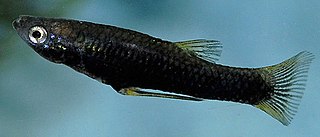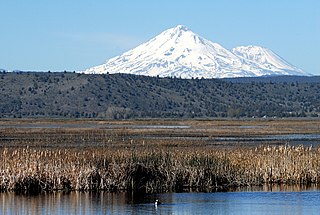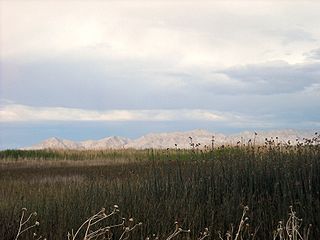| Leslie Canyon National Wildlife Refuge | |
|---|---|
IUCN category IV (habitat/species management area) | |
 | |
Map of the United States | |
| Location | Cochise County, Arizona, United States |
| Nearest city | Douglas, Arizona |
| Coordinates | 31°35′19″N109°30′42″W / 31.5885°N 109.51174°W Coordinates: 31°35′19″N109°30′42″W / 31.5885°N 109.51174°W |
| Area | 2,770 acres (11.2 km2) |
| Established | 1988 |
| Governing body | U.S. Fish and Wildlife Service |
| Website | Leslie Canyon National Wildlife Refuge |
Leslie Canyon National Wildlife Refuge is a National Wildlife Refuge of the United States located in Arizona. The 2,770-acre (11.2 km2) refuge was established in 1988 to protect habitat for the endangered Yaqui Chub (Gila purpurea) and Yaqui Topminnow (Poeciliopsis occidentalis sonorensis). The refuge also protects a rare velvet ash-cottonwood-black walnut gallery forest.

National Wildlife RefugeSystem is a designation for certain protected areas of the United States managed by the United States Fish and Wildlife Service. The National Wildlife Refuge System is the system of public lands and waters set aside to conserve America's fish, wildlife, and plants. Since President Theodore Roosevelt designated Florida's Pelican Island National Wildlife Refuge as the first wildlife refuge in 1903, the system has grown to over 562 national wildlife refuges and 38 wetland management districts encompassing more than 150,000,000 acres (607,028 km2).

Arizona is a state in the southwestern region of the United States. It is also part of the Western and the Mountain states. It is the sixth largest and the 14th most populous of the 50 states. Its capital and largest city is Phoenix. Arizona shares the Four Corners region with Utah, Colorado, and New Mexico; its other neighboring states are Nevada and California to the west and the Mexican states of Sonora and Baja California to the south and southwest.

The Yaqui topminnow is a species of fish in the family Poeciliidae. Its scientific name is Poeciliopsis sonoriensis; it is also sometimes considered a subspecies of Poeciliopsis occidentalis as P. o. sonoriensis.
This area is part of the basin and range geologic region, characterized by linear mountain ranges which are separated by broad, flat basins. The region was impacted by relatively recent volcanic activity, leaving volcanic plugs and cinder cones visible throughout the San Bernardino Valley. Earthquakes have further altered the region and helped allow the flow of many springs and seeps. All of these dynamic geological events have played major roles in shaping the valley, catching and storing crucial water, helping determine the variety of plants and animals present.

A depression in geology is a landform sunken or depressed below the surrounding area. Depressions form by various mechanisms.

The San Bernardino Valley of Arizona is a 35-mi long (56 km) northeast-by-southwest trending valley in extreme southeast Cochise County, Arizona. The north end of the valley merges into the northwest-by-southeast trending San Simon Valley; both merge in western perimeter Hidaldgo County, New Mexico. The valley is an asymmetric graben.

An earthquake is the shaking of the surface of the Earth, resulting from the sudden release of energy in the Earth's lithosphere that creates seismic waves. Earthquakes can range in size from those that are so weak that they cannot be felt to those violent enough to toss people around and destroy whole cities. The seismicity, or seismic activity, of an area is the frequency, type and size of earthquakes experienced over a period of time. The word tremor is also used for non-earthquake seismic rumbling.
The San Bernardino Valley once supported permanently flowing creeks, springs, and marshy wetlands. In addition, the giant sacaton grassland in the valley was once described as "a luxuriant meadow some eight or ten miles long and a mile wide." The dependable source of water and grass made the area not only invaluable to a huge diversity of fish and wildlife, but also a center of human activity for centuries.

A meadow is a open habitat, or field, vegetated by grass and other non-woody plants. They attract a multitude of wildlife and support flora and fauna that could not thrive in other conditions. They provide areas for courtship displays, nesting, food gathering, pollinating insects, and sometimes sheltering, if the vegetation is high enough, making them ecologically important. There are multiple types of meadows, such as agricultural, transitional, and perpetual, each important to the ecosystem. Meadows may be naturally occurring or artificially created from cleared shrub or woodland.
With expanding settlement beginning in the late 19th century came farming, mining, and livestock production, all of which competed for the same precious water. While the extensive wetlands here once provided historic habitat for eight different kinds of native fish, the lowering water table led to severe changes in the habitat and the eventual local extinctions of many species.

Mining is the extraction of valuable minerals or other geological materials from the earth, usually from an ore body, lode, vein, seam, reef or placer deposit. These deposits form a mineralized package that is of economic interest to the miner.

Livestock is commonly defined as domesticated animals raised in an agricultural setting to produce labor and commodities such as meat, eggs, milk, fur, leather, and wool. The term is sometimes used to refer solely to those that are bred for consumption, while other times it refers only to farmed ruminants, such as cattle and goats. Horses are considered livestock in the United States. The USDA uses livestock similarly to some uses of the term “red meat”, in which it specifically refers to all the mammal animals kept in this setting to be used as commodities. The USDA mentions pork, veal, beef, and lamb are all classified as livestock and all livestock is considered to be red meats. Poultry and fish are not included in the category.

In biology, extinction is the termination of an organism or of a group of organisms (taxon), usually a species. The moment of extinction is generally considered to be the death of the last individual of the species, although the capacity to breed and recover may have been lost before this point. Because a species' potential range may be very large, determining this moment is difficult, and is usually done retrospectively. This difficulty leads to phenomena such as Lazarus taxa, where a species presumed extinct abruptly "reappears" after a period of apparent absence.

















